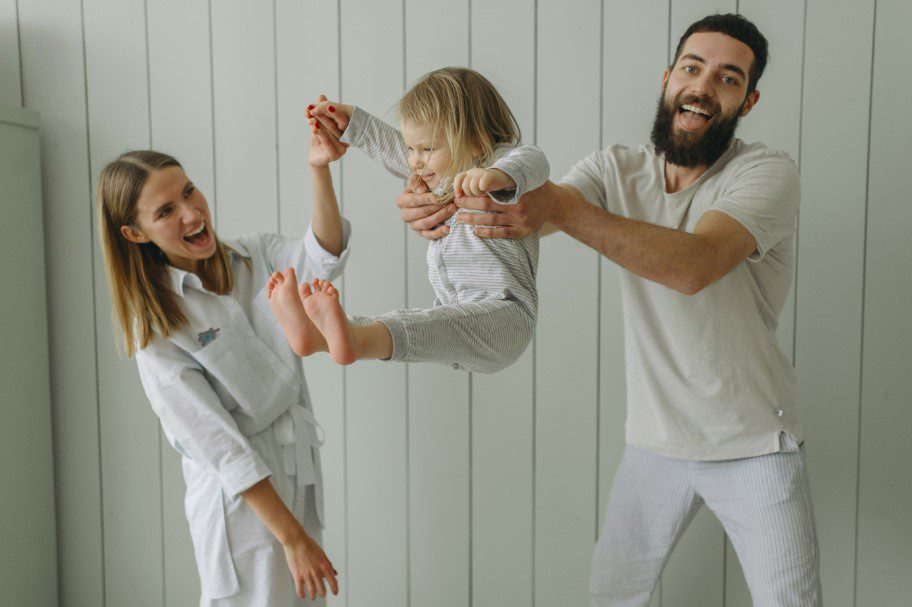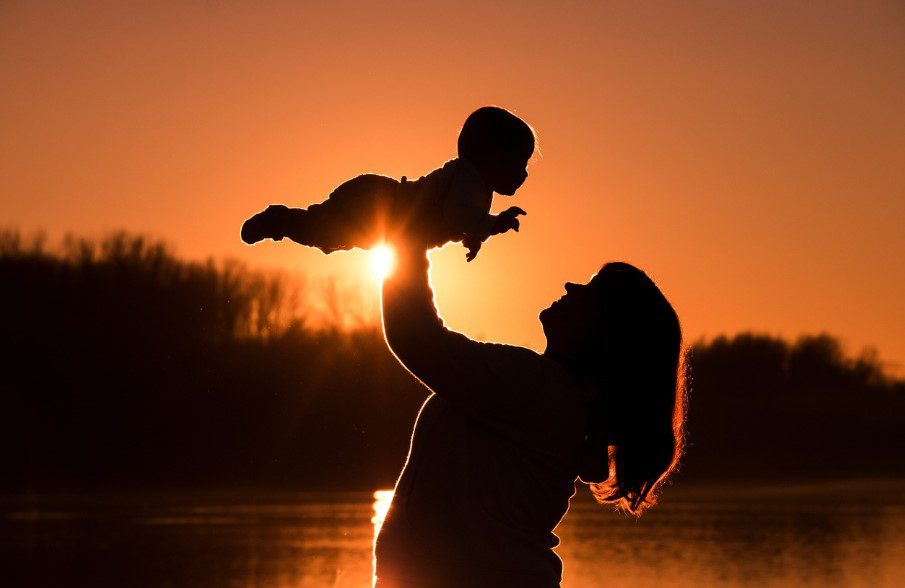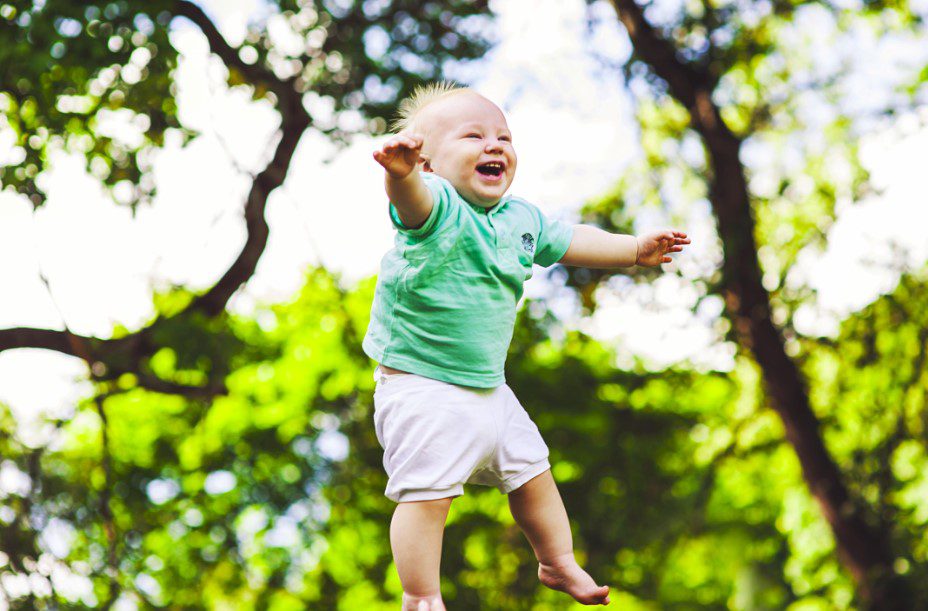Baby tossing is a parenting practice that has been around for centuries, and continues to trigger contentious debates. While numerous parents eagerly participate in this activity, many others approach it with caution.
Often referred to as baby yoga or baby flying, this playtime for parents and babies can be traced back to various cultures, primarily in Asia. It involves gently tossing a baby into the air and catching them as they fall back.
The image is vivid and captivating, as the little infant takes flight into the open air, only to be safely caught and returned to the arms that launched them.
Continuing research demonstrates how crying in babies is usually the main reason why many parents adopt baby tossing.
According to National Library of Medicine, in regards to baby tossing,
the early increase in crying in otherwise normal infants in the first few months of life as a trigger for the abuse.
Somehow, the practice catches up in many families and becomes a habit as the years go by.
The question is, how safe is this practice from a scientific perspective?
The Potential Drawbacks of Baby Tossing – the Scientific Perspective:

If the force during baby tossing is not gentle and controlled, it can lead to unintended and potentially unsafe outcomes.
Here are some drawbacks associated with baby tossing:
1. Safety concerns and scientific perspective
When a baby is tossed into the air, the force of gravity plays a central role in the activity. Gravity acts to pull them back down to the ground. The same gravity can actually affect several organs and fluids in the body, particularly in the head.
Pediatricians and child development experts began raising several questions regarding this starting in the 1970s.
In the early 1970s, English neurosurgeon A. Norman Guthkelch and American radiologist John Caffey each published articles positing that violent, abusive shaking of infants could produce subdural hematoma (bleeding beneath the dura layer in the brain).
clcjbooks
For starters, babies’ brains are still developing and are more vulnerable to injury. A baby’s brain is approximately 75% of the size of an adult’s brain by the time they are born. However, it continues to grow and develop rapidly in the first few years of life.
The brain is made up of soft tissue that is surrounded by cerebrospinal fluid. This fluid acts as a cushion to protect the brain from injury.
However, the cerebrospinal fluid is not fully developed in babies, making their brains more vulnerable to injury.
Secondly, babies’ heads are large and heavy in proportion to their bodies. A baby’s head is about 25% of their total body weight. This is much higher than the proportion of an adult’s head to their body weight. The weight of the baby’s head can put a lot of stress on their neck muscles, which are still developing. This makes it difficult for them to control the movement of their heads.
When babies are tossed, their heads and necks move back and forth suddenly. This is known as whiplash. Whiplash can damage the brain and blood vessels in the neck.
2. Health challenges due to baby tossing
- Shaken baby syndrome (SBS), or abusive head trauma (AHT), is a serious condition that can cause brain damage, bleeding, and even death in babies.
Shaken baby syndrome is a type of brain injury that happens when a baby or young child is shaken violently. When this happens, the brain can bounce back and forth against the skull which can cause bleeding, bruising, and swelling.
NIH
- Concussions: These are brain injuries that can cause a variety of symptoms, including headache, dizziness, nausea, and vomiting.
- Brain bleeds: These can cause a variety of symptoms, including seizures, coma, and death.
- Retinal damage: This can lead to vision problems or even blindness.
- Serious injury or death: Baby tossing can result in serious injuries or death. Injuries include head injuries, neck injuries, and spinal cord injuries.
- Heart issues: If a baby has any pre-existing heart conditions, even gentle tossing could be risky.
- Developmental delays: Baby tossing may interfere with the baby’s normal development. This is because the baby is not ready to experience such rapid and intense movements.
- Emotional distress: Baby tossing may cause the baby to experience emotional distress, such as fear and anxiety.
3. Age matters
Baby tossing is bad at any age, but it is especially dangerous for babies under 6 months old. This is because their necks are not strong enough to support the heavier weight of their heads.
Also true, babies have soft, growing bones that are more susceptible to fractures. A fall from even a short height can cause serious injury.
Even for older babies (up to 4 years), tossing them in the air is still a bad activity. Because of increasing body weight, in relationship to age, there is always the risk of being dropped or falling, which can lead to head, neck, and spinal cord injuries. Furthermore, some children may develop a fear of heights from being tossed in the air before they are ready.
4. Fear and anxiety
The experience of being tossed in the air can be frightening for a baby, especially if they don’t feel secure or trusting of the caregiver. This can lead to anxiety and affect their emotional well-being.
Here are probable effects:
- Sensory overload: The sudden change in position, unfamiliar feeling of weightlessness, and potential rush of wind can be overwhelming for a baby’s developing senses.
- Fear response: This sensory overload can trigger a natural fear response in a baby, leading to anxiety and crying.
- Long-term impact: And like mentioned above, repeated negative experiences of being tossed can contribute to a fear of heights later in life.
And yes, some babies might enjoy the gentle sensation of being tossed, but it is always best to err on the side of caution and prioritize their sense of security and well-being.
5. Accidents can happen
Even with the best intentions and good physical ability, tossing a baby, especially one under four, is a risky activity. An unexpected movement by the baby or a misstep by the caregiver could lead to dropping the baby.
Babies are constantly developing and their movements can be jerky or sudden. This can make it difficult to anticipate and react to their movements during a toss.
Just as well, even a strong adult can lose their grip due to a slip, stumble, or unexpected movement from the baby. A fall from even a short height can be dangerous for a baby’s fragile body. Head injuries, broken bones, and spinal cord damage are all potential risks.
The Potential Benefits of Baby Tossing!

1. Bonding and Trust
Proponents of baby tossing claim that it can strengthen the bond between the parent and the child. The act of tossing a baby into the air and catching them can promote trust and a sense of security between the two.
2. Sensory Stimulation
Baby tossing is believed to provide sensory stimulation. Advocates argue that the movement and change in perspective as the baby is gently lifted and caught can help stimulate their senses and foster their spatial awareness.
3. Motor Skills
Supporters of baby tossing also suggest that it can aid in the development of motor skills. The act of coordinating movements during the toss and catch is thought to contribute to a child’s physical development.
The Bottom Line
Despite the positive words listed above, the simple fact is that baby tossing in the air is simply not worth the risk. As mentioned earlier, even if a baby does not show immediate signs of injury, they may still have suffered internal damage.
Some symptoms may be noticed immediately while others become evident as the child grows older.
NIH
If you see someone tossing a baby and shaking them violently, it is important to speak up and intervene. You can explain the risks and offer to help them play with the baby in a safer way.
Here are some tips for playing with babies safely:
- Always support the baby’s head and neck.
- Avoid any play that involves sudden movements or jostling.
- Keep the baby close to the ground.
Alternatively, there are many fun and safe ways to interact with and play with a baby that don’t involve tossing them in the air. Here are a few ideas:
- Peek-a-boo
- Singing songs
- Making silly faces
- Dancing together
- Reading books
The Last Word:
Whether or not baby tossing is scientifically safe is a subject that requires further research and consideration. While anecdotal evidence may suggest that some babies enjoy being gently tossed in the air and do not suffer any apparent harm, the potential risks of neck strain, spinal injuries, or shaken baby syndrome must be carefully evaluated through empirical studies and medical research.
It is important that parents and caregivers prioritize the safety and well-being of infants, and exercise caution when engaging in select parenting activities that could pose a risk of injury. Until more conclusive evidence is available, it is advisable to err on the side of caution and avoid baby tossing as a form of play.





Leave a Reply